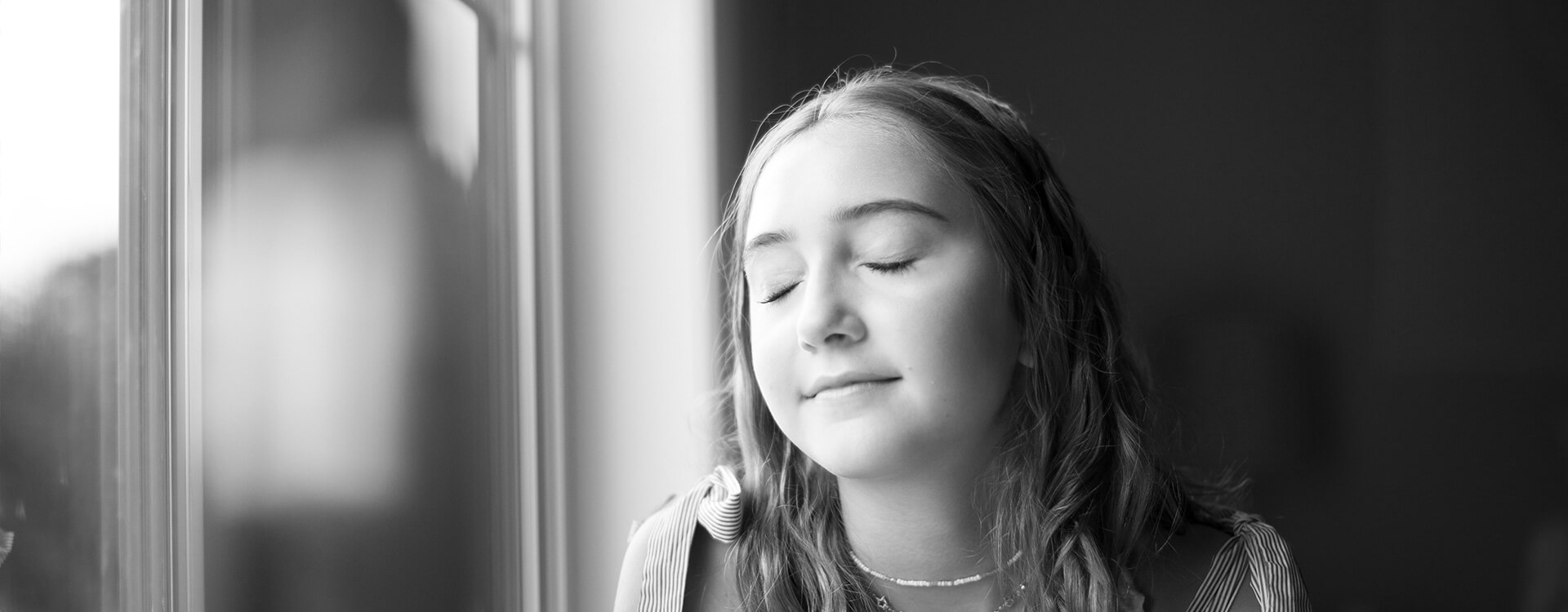Sammy
Living with limb-girdle muscular dystrophy type 2I/R9, Lancaster, PA
“I’m not afraid of much. Sometimes I’m afraid of limb-girdle, but most of the time I’m not.”
Meet Sammy – not just another diva
With great excitement, Sammy unwraps a nondescript black box to discover which new cosmetics made their way to her doorstep. Holding her hand steady and focusing her eyes into the mirror she begins to experiment. Once she’s satisfied, she washes the product off and starts anew. For Sammy, makeup is about far more than a pleasing outward appearance. “I actually don’t love having tons of makeup on my face,” she says. “I am not allowed to wear it to school.” Cosmetics are her outlet for self-expression—an art form with practical applications.
“She was a total diva as a little girl,” says her mother, Kelly. After learning to walk she gravitated toward her mother’s closet. “She rocked my high heels and sparkles and handbags,” Kelly recalls. “People used to say she had this cute little strut.” Sammy would sway her hips widely when she walked. “I thought she was just imitating someone.”
Walking into answers
Kelly had little idea then that the characteristic sway of Sammy’s hips was Trendelenburg gait, an early sign of limb-girdle muscular dystrophy (LGMD), a muscle-wasting disease that weakens the muscles close to the body, including the hips, upper-arms, thighs, and shoulders. Type 2I/R9 is one of over 30 known types. “Most medical specialists have never heard of LGMD,” comments her father, Keith, a career podiatrist. “We just stumbled quickly upon a diagnosis. We got lucky.” Due to her parents’ proactive attitude and willingness to learn, Sammy is well prepared in her fight against this rare disease. Her diagnosis was the spark for her family’s advocacy as they take real steps toward finding a treatment that could benefit the entire LGMD community.
Kelly, who has worked as a speech pathologist for years, took note of Sammy’s difficulty keeping up with her peers physically, her exhaustion from simple tasks, and her tendency to take hard falls, even around the house.
Keith concurred with Kelly’s observations. “As a podiatrist, I watch people’s gait,” he says. “I could tell something was off.” They had a physical therapist work with Sammy at the age of two to see if her balance could be improved. Sammy progressed steadily but one day after a session, the therapist somewhat casually mentioned something that immediately shifted their perception of Sammy’s condition. Kelly recalls, “He said, ‘I’m happy to work with her—she’s reaching her goals—but it’d be nice to have a diagnosis.’ That was the first time anyone had said, ‘I want a name for this.’ I just thought she was a little delayed.”
A diagnosis and a doctor’s order
The words jolted Keith and Kelly but also motivated them to find answers. A physician in the family suggested they take Sammy to be evaluated by a neuromuscular clinic, and after several visits, a neurologist diagnosed Sammy with LGMD. To find out more, they would need to order genetic tests, but the cost was prohibitive. Keith reached out to other physicians and found a study that Sammy could participate in at the National Institutes of Health (NIH), which covered the costs of necessary testing. Just before her third birthday, Sammy was diagnosed with Type 2I/R9, which follows a recessive inheritance pattern, where an individual inherits two copies of a gene, one from each parent.
The diagnosis raised serious questions. “We were at the geneticist’s office, and we asked, ‘What can we do?’” says Kelly. The only investigational treatments that may benefit Sammy were in the early stages of development—only a faint road map to better health. Members of the NIH were straightforward with Kelly and Keith and encouraged them to start a foundation to raise funds for much needed LGMD 2I/R9 research. The prospect was daunting—Keith and Kelly were only beginning to grapple with the implications of their daughter’s disease—and the only direction necessitated more hard work. However, they rose to the challenge, successfully creating the first patient foundation specifically focused on funding investigation of potential treatments for LGMD 2I/R9—The Samantha Brazzo Foundation (now known as CureLGMD R9). “We’re not going to beat [LGMD 2I/R9] by waiting for someone else to do it for us,” says Kelly. “It was literally a doctor’s order—the NIH told us to create a foundation and we did.”
The growth of the Foundation is matched by emerging drug developments for LGMD 2I/R9 and the first conference for all of the LGMDs. “In the last 12 months, I’ve heard more exciting news than I’ve heard in the last eight years combined,” says Kelly optimistically. “We promised Sammy that we would have something figured out by the time she starts high school.”
“That’s only three years away,” Sammy is quick to add.
“So we still have time,” responds Kelly.
Courage in the face of challenge
In the meantime, Sammy adapts to her changing physical abilities, while still nurturing her talents with a positive attitude. “It’s kind of annoying,” says Sammy, about her LGMD 2I/R9. “Like when I can’t do some of the stuff in gym or at recess. But now I don’t really care anymore. It’s not going to change. I just got used to it.”
“She has more physical challenges than the average kid, but we try not to treat her differently,” says Kelly. “She doesn’t get special privileges.” Homework, chores, and church are all required in this household as Kelly and Keith try their best to instill good values and a strong work ethic. However, there is also ample time for fun. Sammy is elated as she describes her trips to New York, the Jersey Shore, and Marco Island, Florida.
Her family’s courage and advocacy are changing the prospects for LGMD 2I/R9 and opening the possibility of finding a treatment, which strengthens Sammy’s resolve.
“I’m not afraid of much,” she says. “Sometimes I’m afraid of limb-girdle, but most of the time I’m not.”

